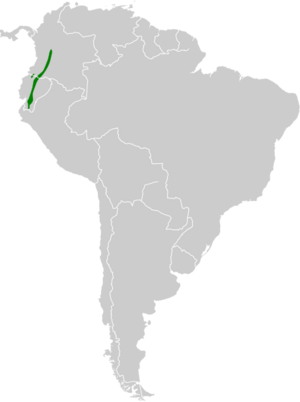Viridian metaltail facts for kids
Quick facts for kids Viridian metaltail |
|
|---|---|
 |
|
| Conservation status | |
| Scientific classification | |
| Genus: |
Metallura
|
| Species: |
williami
|
 |
|
The viridian metaltail (Metallura williami) is a small, colorful hummingbird. It belongs to a group of hummingbirds called "coquettes." You can find this bird in the mountains of Colombia and Ecuador.
How Scientists Classify It
The viridian metaltail has four different types, called subspecies. Think of subspecies as slightly different versions of the same animal. They are:
- M. w. recisa
- M. w. williami
- M. w. primolina
- M. w. atrigularis
For a while, scientists thought M. w. primolina and M. w. atrigularis were separate species. But later, they decided these were just subspecies. Sometimes, as scientists learn more, they change how they classify animals.
What Does It Look Like?
The viridian metaltail is about 11 to 12 centimeters (4.3 to 4.7 inches) long. It weighs between 4.1 and 5.3 grams (0.14 to 0.19 ounces). That's about as much as a few paper clips!
This hummingbird has a medium-sized, straight, black beak. The adult male of the main type (called the "nominate subspecies") is bottle green all over. Its throat patch, called a gorget, sparkles with bottle green. Its tail is purplish-blue and slightly forked, like a small "V."
The adult female also has bottle green upper parts. Her throat, chest, and belly have a mix of green and white spots. The tips of her outer tail feathers are whitish underneath. Young viridian metaltails look a lot like the adult females.
Each subspecies has small differences:
- M. w. recisa has a shorter beak and a more deeply forked tail. Its underside is shinier.
- M. w. primolina's tail is reddish-black on top and shiny green underneath. It's only slightly forked.
- M. w. atrigularis has a black spot in the middle of its sparkling throat patch. Its tail is also slightly forked and shiny green underneath.
Where Does It Live?
The different types of viridian metaltails live in specific areas:
- M. w. recisa lives in the Western Andes mountains of Colombia.
- M. w. williami lives on both sides of Colombia's Central Andes mountains.
- M. w. primolina is found from southern Colombia into northern Ecuador.
- M. w. atrigularis lives in the Andes mountains of southern Ecuador.
These hummingbirds like to live in high-up grasslands called páramo. These grasslands have scattered shrubs. They also live at the edges of wet mountain forests and "elfin forests," which are forests with small, twisted trees.
In Ecuador, they usually live between 2,700 and 3,600 meters (8,900 and 11,800 feet) high. In Colombia, they can go even higher, up to 4,000 meters (13,000 feet). Sometimes, they are seen as low as 2,100 meters (6,900 feet).
How It Behaves
Movement and Travel
Scientists believe the viridian metaltail usually stays in one place. However, male birds might fly to higher areas when it's not breeding season.
What It Eats
The viridian metaltail looks for food at all levels of the plants where it lives. It mainly eats nectar from flowers while hovering in the air. It especially likes shrubs from the Ericaceae and Melastomataceae plant families. Male hummingbirds will protect their favorite feeding spots from other birds.
Reproduction and Life Cycle
The exact breeding season for the viridian metaltail isn't fully known. It seems to happen between February and August. The birds build their nests using moss and soft plant fluff, along with small feathers. They often place these nests in rocky spots or other sheltered places. The female bird lays two white eggs and keeps them warm until they hatch.
How It Communicates
One of the viridian metaltail's calls sounds like "a descending series of 3–5 squeaky notes." These notes are often followed by "several jumbled dry buzzy trills." It also makes "repeated dry buzzy or gravelly notes."
Its Conservation Status
The IUCN (International Union for Conservation of Nature) has listed the viridian metaltail as "Least Concern." This means it's not currently in danger of disappearing. However, its population size is unknown, and it is thought to be decreasing.
Even though it lives in a large area and in some protected places, its páramo habitat is shrinking. People often burn these grasslands to create land for cattle to graze. This loss of habitat is a challenge for the viridian metaltail.


